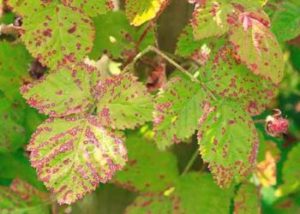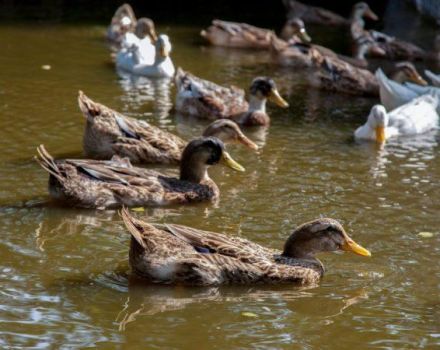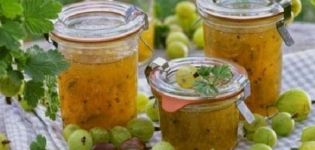How to propagate blackberries with air layers and green cuttings at home
Reproduction of any varieties of blackberries is not as difficult as it might seem at first glance. There are many ways to plant blackberry bushes. Each of them has advantages and disadvantages.
Why is it worth propagating garden blackberries?
The cultivation of blackberries does not require special knowledge, as many summer residents may think. Growing blackberry bushes is no more difficult than growing raspberries or fruit trees. Blackberry bushes are still rarely found in domestic plots, although blackberries are unpretentious plants and it is very easy to care for them. The advantage of garden blackberry is a large amount of vitamins and minerals in ripe fruits. The berries are juicy and sweet, and they also make delicious jam.
The specifics of the reproduction of blackberries at different times of the year
It is not so difficult to grow blackberries at home. Planting at certain times of the year differs in its specificity. Most of the plants are planted in spring and autumn. In summer, the bushes are planted in extreme cases, when there is no other way plant blackberry bushes... In autumn, it is recommended to plant the plant in the southern and central regions.
High humidity contributes to the spectacular growth of roots in winter. With the onset of spring, seedlings are actively growing.
When planting cuttings in spring, they do not have time to take root before the onset of heat. And when the heat comes, the cuttings immediately begin to build up deciduous mass, which does not have a very good effect on the yield and plant health. In autumn, cuttings are planted one month before the onset of cold. And in the spring, you need to plant cuttings until the air temperature rises to +15 degrees.
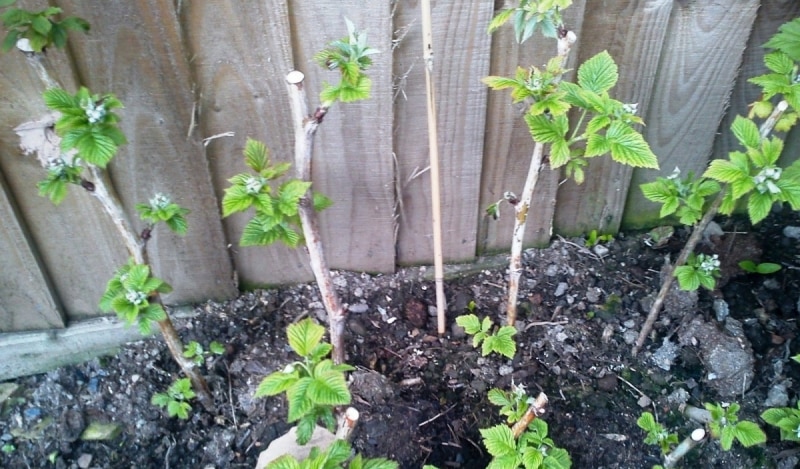
Reproduction methods
There are many ways to propagate blackberries in the garden. Some of them are simple enough that even a beginner in gardening can handle berry propagation. Only an experienced summer resident can handle other cultivation methods. Each method of growing blackberries also has its pros and cons.
Tops
Top propagation is suitable for climbing and climbing varieties that develop long and resilient shoots... As a rule, this is how the plant reproduces in the wild. Top propagation is suitable for beginners in gardening and for those summer residents who do not want to spend a lot of time on it. Plant propagation stages:
- In the period from the first decade of July to the first days of August, you need to bend the tops of young shoots to the soil.
- The upper 15 cm must be covered with soil or hilled.
- After about a month, the tops will give roots and begin to actively develop.
- With the onset of autumn, the tops are covered with spruce branches or straw.
- In the spring they are carefully cut off from the mother bush and transplanted to a new place.

This breeding method is considered one of the simplest, but at the same time effective. Rarely which of the tops do not give roots.
By dividing the bush
Growing crops by dividing a bush is most common among summer residents. Almost any plant can be planted this way. And blackberries are no exception. Any kind of berry can be diluted with this method.
Cultivation of a shrub in this way is suitable if there are no young shoots on the berry, and other methods are not suitable.
Stages of growing blackberries by dividing the bush:
- In the spring or fall, blackberry bushes are dug up.
- After that, the bush is divided in such a way that there are 2-3 healthy shoots on each part. In this case, there must be at least one kidney on the roots.
- As a rule, 6-7 bushes are obtained from one adult bush.
- After that, the separated seedlings are transplanted to a permanent place.

This method is suitable if the shrub has grown a lot and needs to be transplanted.
Root offspring
With the onset of spring, each plant begins to expel root suckers for further reproduction. As soon as the root suckers reach a length of 15 cm, they must be cut off with a sharp secateurs and transplanted to a new place. In order not to wait for autumn, this process can be accelerated. In autumn, a large lump of soil is left on the rhizome. Thus, the plant will not feel any changes, which means it will not hurt in the spring.
Layers
It is best to propagate climbing blackberry varieties with apical layers. A large number of bushes can be obtained if the mother plant has grown enough, and those shoots that could yield a crop are not particularly needed:
- Next to the kut, you need to dig a trench to a depth of 20 cm.
- At the end of summer, you need to attach the shoot to the soil and bury it.
- Only the tops should remain on the soil surface.
- After the shoot is completely covered with earth, it is pinched on both sides. On the one hand, at the base. On the other, at the top.
- Then the shoot is mulched and watered abundantly.
- After about 2 months, the first roots appear, as well as new shoots.

In the spring, you can start transplanting the layers to a new place.
Reproduction in water by a sleeping bud
This method is time consuming, but very effective. Blackberry breeding stages:
- In early October, cut young cuttings about 15 cm long. Cut the leaves, and place the shoots in the refrigerator.
- In February, remove the cuttings, place them in a jar of water so that only one bud is in the water.
- A jar of cuttings should be kept in the sun and the water should be changed periodically.
- After a while, roots will appear from the cuttings, after which the lower part of the cuttings is cut off and planted in a container with soil.
- The second bud is immersed in water, and it will also give roots.
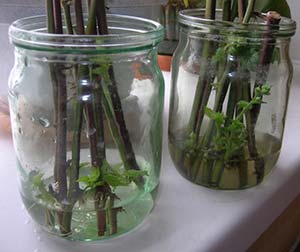
In this way, several seedlings can be grown at once. In the spring, cuttings with roots are planted in a permanent place.
Cuttings
You can plant a blackberry using cuttings. This method is suitable for any kind of berry. The advantage of cuttings is that the maximum number of seedlings can be obtained at the lowest cost.
Cutting process:
- In autumn, cuttings 40 cm long are cut from young, but already lignified shoots.
- Then you need to bury them with earth to a depth of 20 cm.
- With the onset of spring, dig up the cuttings, cut them off on both sides by 5 cm and cover them with soil again.
- Cuttings are weeded and watered regularly.
- When the first pair of leaves appears, the cuttings are dug out of the ground and planted in separate pots.
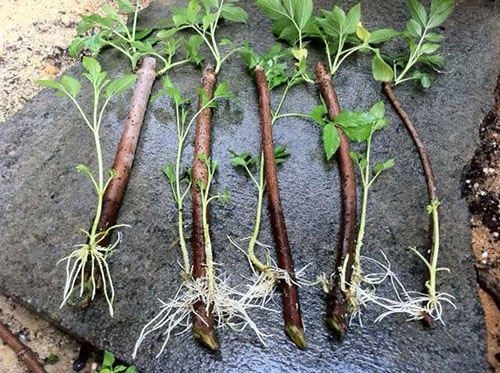
After new leaves appear on them, the blackberries are planted in a permanent place.
Stem cuttings
Planting with stem cuttings by technology is exactly the same as conventional cuttings.
Seeds
Growing blackberries by seed method is the longest. From the moment of planting the seeds to the appearance of the first berries, at least 5 years pass. In addition, not all novice summer residents will be able to cope with this matter. The germination rate of store seeds is very low and is only 10%. The germination of seeds harvested by hand reaches 80%. To get seeds, you need to collect overripe berries and mix them. As a result, the seeds should separate. Rinse the blackberry gruel several times in water through cheesecloth to wash the seeds.
Spread the seeds on gauze and dry. Then you need to remove them in a dark room for 2-3 months. For example, in the refrigerator. Place the seeds in a container and cover with wet sand.
In the spring, seeds are planted in the ground. Containers with future sprouts are placed under phytolamps. In the fall, seeds are planted in open ground. Do not be afraid that the sprouts will freeze. Such conditions are quite natural for blackberries. In the spring, after the snow melts, the first shoots should appear. When they grow up, they are seated.
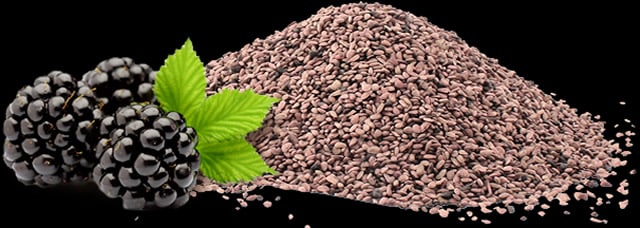
The advantage of seed growing is the ability to care for seedlings at home. In addition, sprouts can be planted in spring at any time after the end of night and day frosts. You can also control the quality and quantity of blackberry seedlings. Minus - the sprouts will have to create favorable conditions for them to germinate.
Green cuttings
Another easy way to propagate blackberries is with green cuttings. To do this, in the summer, when the leaves are completely formed in the bushes, several shoots are cut off. These shoots are then cut as cuttings. Cut off a couple of lower leaves, leaving only the top.
Each seedling is planted in separate containers (peat cups can be used). The containers are placed in a dark, warm room and covered with cling film to create a greenhouse effect. The cuttings are regularly ventilated and watered. After 2 weeks, the roots should appear. After another week, you can plant the blackberry in a permanent place and root it there. This method is good in that a large number of berry seedlings can be grown with a minimum amount of time.
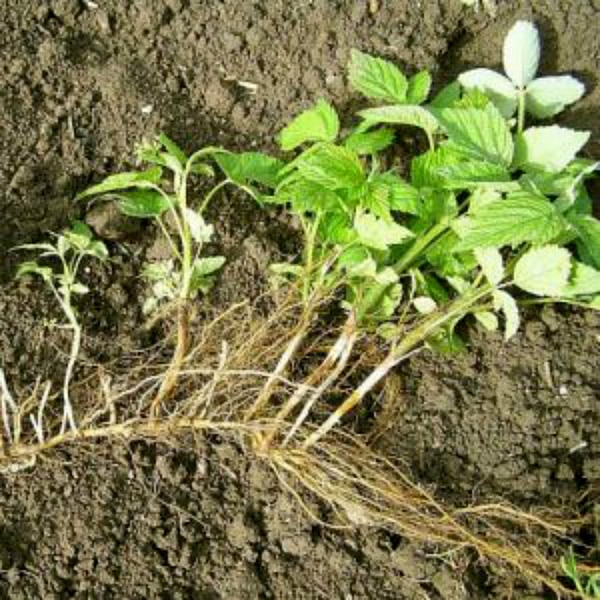
How to propagate thornless blackberries?
Thornless blackberry propagates by apical layers. But other ways are also fine. When growing, it should be remembered that in the first year the shoots do not bear fruit, and in the second year the lateral shoots with fruits, although they are formed, then completely die off.
For planting thornless varieties, attention should be paid to the composition of the soil. Before planting cuttings with roots, the soil is mixed with wet sand, peat and mineral fertilizers. The thickness of the fertile soil is about 10 mm.
Possible mistakes
The main mistake when growing blackberries is strictly following the recommended planting dates, even if the weather conditions are unfavorable. The cuttings should be rooted immediately in the soil at their permanent planting site. During transplantation, the delicate roots can be damaged. Another mistake is non-compliance with the rules of agricultural technology. Many gardeners do not pay attention to care during blackberry breeding, which is also a mistake.

